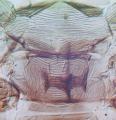Dichromothrips corbetti
Recognition data
Distinguishing features
Female fully winged. Body dark brown, tarsi and apices of tibiae yellow; fore wing brown with base pale. Antennae 8-segmented, III & IV with apex narrowed and bearing long forked sensorium. Head wider than long, with 2 pairs of ocellar setae, Pair III anterolateral to ocellar triangle. Pronotum with strong transverse lines of sculpture, with no long setae. Metanotum with distinctive transverse lines of sculpture, median setae arising behind anterior margin. Fore wing first vein with 2 setae distally, second vein with at least 15 setae. Tergites without sculpture medially, but lateral thirds with many closely spaced transverse lines; VIII with regular comb of long microtrichia; X without longitudinal split. Sternite VII with 2 pairs of median setae arising well in front of posterior margin.
Male fully winged; tergite IX without stout setae; sternites III–VII each with a pair of pore plates.
Related and similar species
Dichromothrips includes 18 species from orchids in the Old World tropics. An identification key to 14 of these is given by Mound (1976), and Okajima (1999) provides information on four species from Borneo. D. corbetti differs from the other members of the genus in having no elongate posteroangular setae on the pronotum, whereas the other species have either one or two pairs of such setae. The genus is possibly related to Taeniothrips, in which the species breed mainly on leaves.
Taxonomic data
Current valid name
Dichromothrips corbetti (Priesner)
Original name and synonyms
- Anaphothrips corbetti Priesner, 1936: 209
Family placement
Thripidae, Thripinae
Common names
Orchid thrips
Biological data
Life history
Breeding on leaves and in flowers.
Host plants
Recorded from various cultivated Orchidaceae
Tospoviruses vectored
None
Crop damage
Causing scarring on flowers of Vanda orchids.
Distribution data
Area of origin
South East Asia.
Distribution
Recorded widely around the world; likely to be imported to California, or intercepted in quarantine.







